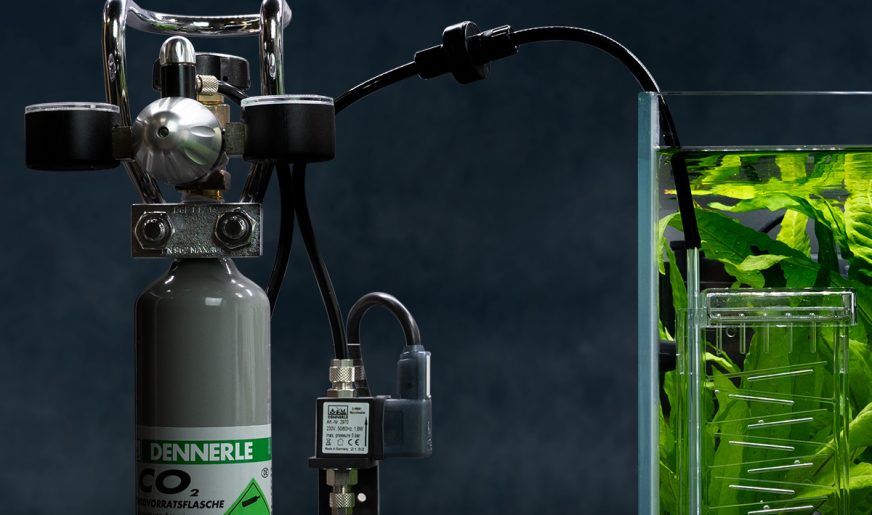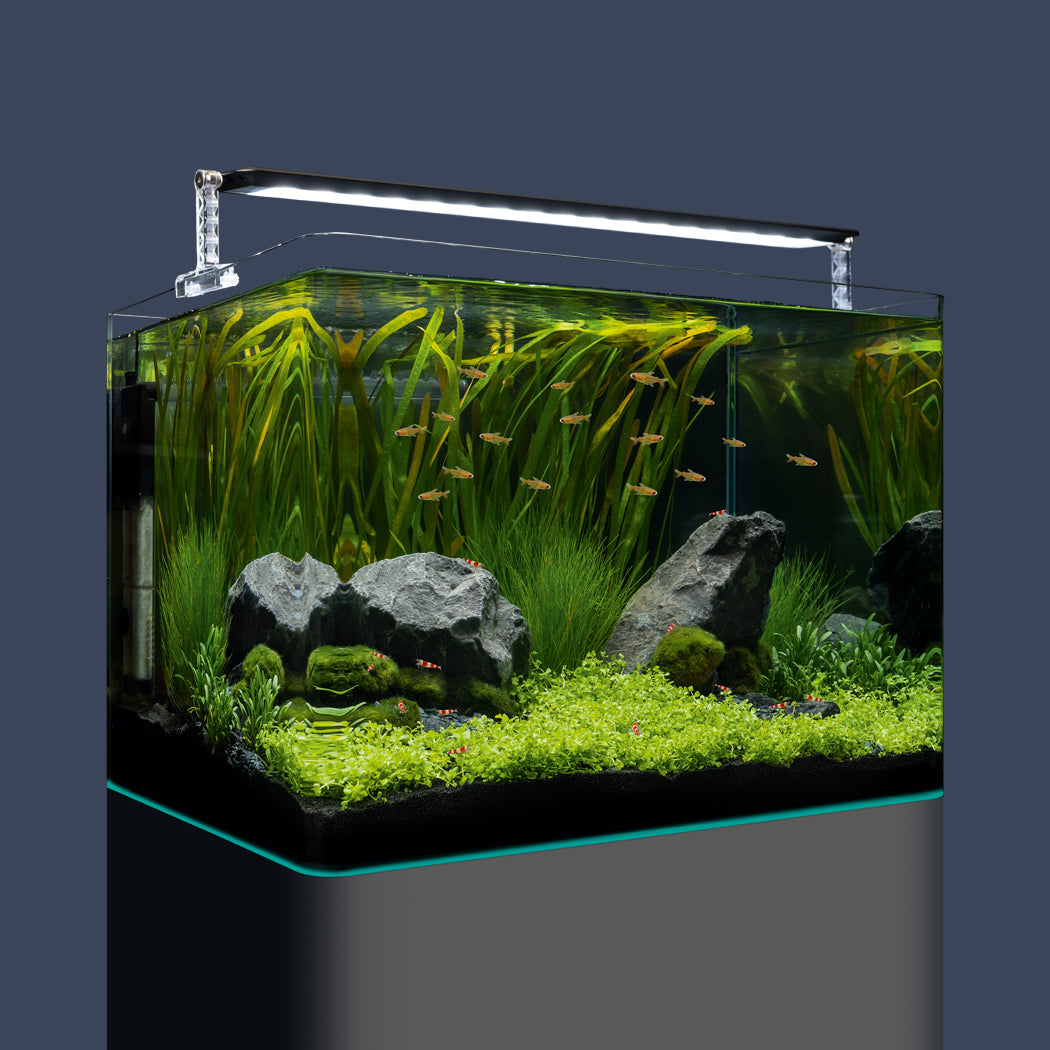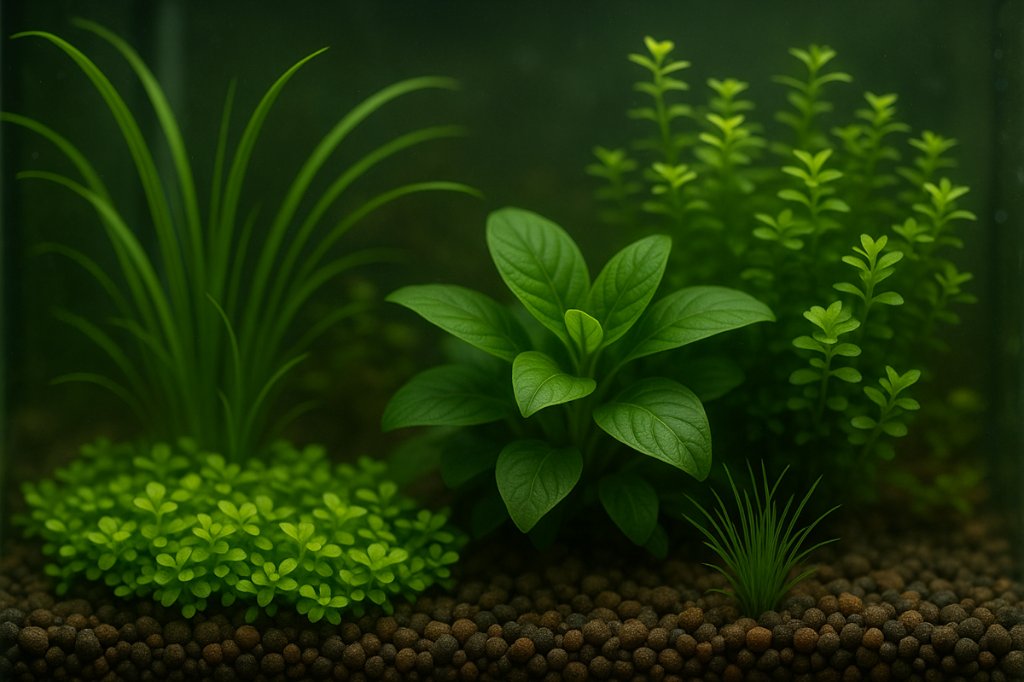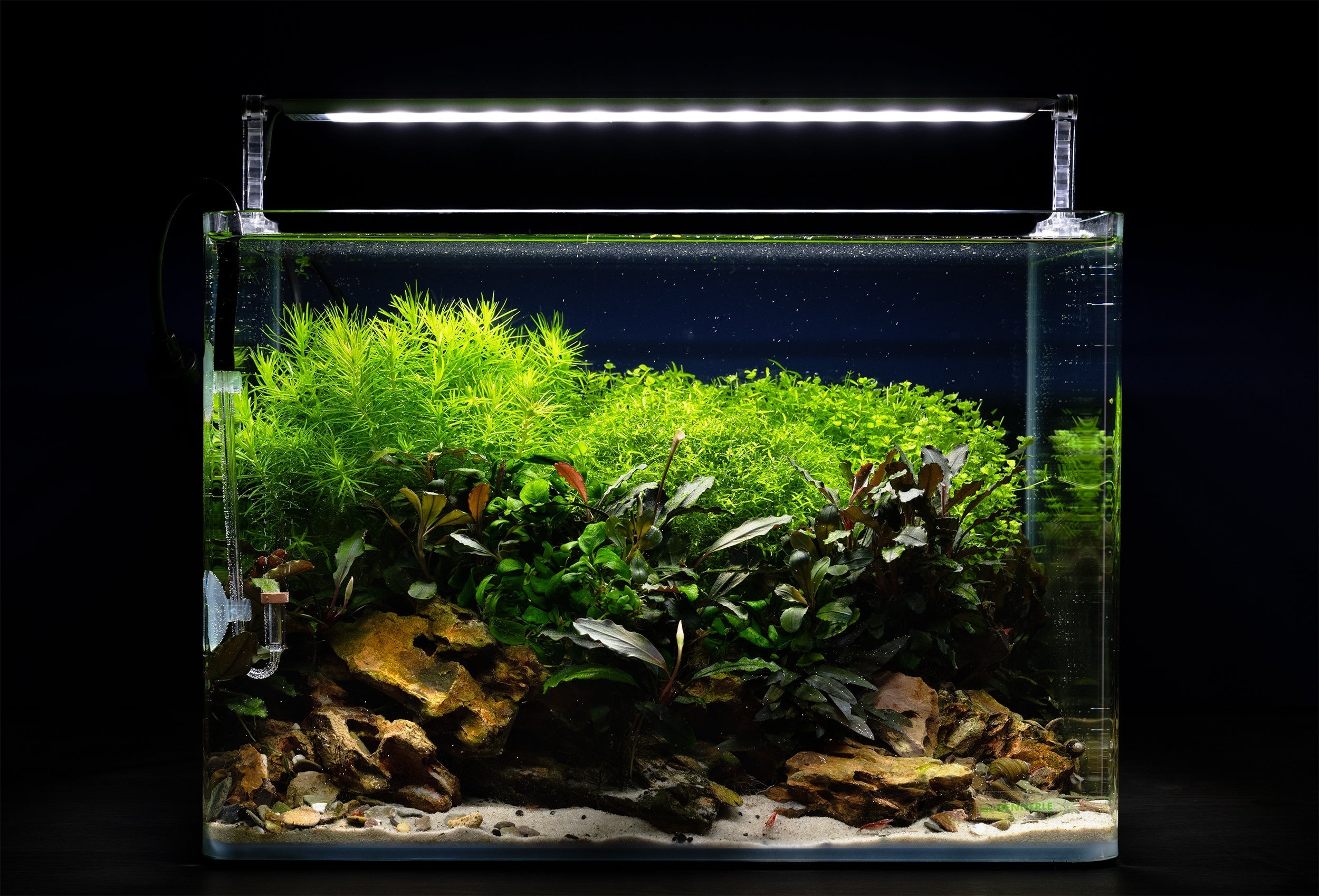In this article we explain everything about carbon dioxide in aquaristics. We clarify frequently asked questions and want to give you everything you need to operate your aquarium with CO2.
What do plants do with carbon dioxide?
With the help of photosynthesis plants produce simple and multiple sugars from carbon dioxide and water. The necessary energy for this process is provided by natural or artificial light. The sugars serve as energy stores and help them build their tissues. At the same time, this process releases the vital oxygen that fish, invertebrates and bacteria need to live. Almost half of the dry mass of a plant consists of carbon. Without this essential nutrient, there is no plant growth! Many natural waters with dense, beautiful plant populations therefore have an enormously high CO2 content of up to 50 mg/L, which comes mainly from seepage sources and the activity of bacteria at the bottom, which metabolize organic residues.
Of course, there are also waters where much less CO2 is dissolved in the water. There, plant growth is rather meager, and in some cases there are severe algae plagues.
We can transfer these findings from nature, because vigorously growing green and red aquarium plants are wonderful to look at and also play a supporting role in the ecosystem in the aquarium. Plants need nutrients to grow, which are produced during the decomposition of organic waste. Aquarium plants use the macronutrients phosphate, ammonium, nitrate and potassium in particular in large quantities and incorporate these substances, some of which are harmful to aquarium animals, into their tissue or use them for their metabolism.
In return, plants produce oxygen, which your aquarium animals and also the filter bacteria need to survive – by the way, the plants themselves are also dependent on oxygen, as living beings they also breathe. A good oxygen supply in the aquarium is the be-all and end-all for sensible fish keeping and a healthy ecosystem.
And: Vigorously growing aquarium plants are the best prevention against annoying algae.
The CO2 in the aquarium water
Some CO2 always dissolves from the air in the water. A little of it is exhaled by animals, microorganisms and plants in the aquarium – because plants also breathe! However, the average CO2 content in aquarium water without an additional supply of CO2 is only about 0.5 mg/L. However, most aquatic plants are accustomed to much higher concentrations from their natural home waters, and they will take care of themselves if there is a deficiency. An additional supply of the very water-soluble gaseous CO2 is therefore advisable in order to provide the plants with this important building material in sufficient quantities. But who wants chemistry in the aquarium!
Although CO2 is a chemical compound of two oxygen atoms with one carbon atom, it is a natural gas that is exhaled by plants, animals and humans. CO2 dissolved in water reacts to a small extent with water molecules to form carbonic acid. A moderate addition of CO2 to the aquarium water therefore allows the pH value to drop into a slightly acidic range.
Many of the most popular aquarium inhabitants originally come from soft and slightly acidic waters and thank these favorable conditions in the aquarium with more vitality, bright colors and higher activity. The plants can absorb nutrients more easily, grow better and shine in richer colors.
Will my aquarium work without CO2?
We answer this question with a resounding "yes and no". Of course there are robust aquarium plants that can cope with little CO2, but they also grow better when they are provided with plenty of CO2. At the latest, if you would like to maintain colorful aquarium plants or somewhat more demanding aquatic plants in your aquarium, you can no longer avoid an additional CO2 supply.
With CO2, planted aquariums simply function much better!
The question is how much CO2 is the right amount for my aquarium?
Aquarium fish, shrimps and other invertebrates do not actively exhale carbon dioxide, but simply allow it to diffuse from their well perfused gills into the water and take up oxygen in exchange. Because all substances always migrate into the solution in which there is significantly less of it, this works – but only as long as there is significantly less CO2 in the aquarium water than in their blood. However, if there is already a lot of CO2 dissolved in the aquarium water, the animals can no longer get rid of the gas from their blood.
Even if there is enough oxygen in the aquarium water, the animals cannot excrete the CO2 and therefore cannot absorb oxygen – in the worst case they can even suffocate.
Therefore, a CO2 level of 20 mg/L is generally recommended for planted aquaria – so you are definitely on the safe side! In addition, you should always check the CO2 content of your aquarium water with a continuous test to ensure that the "magic limit" of 20 mg/L CO2 in the water is not exceeded.
For this reason, it is also not recommended to use CO2 to extremely depress a very high pH value.
The Magic Triangle
How are light, CO2 supply and aquarium fertilization related?
Light, CO2 and fertilization are the magic triangle for plant growth. These three factors are directly related and interdependent. If one factor is deficient – for example, if there is too little CO2 in the aquarium water – plant growth stagnates, even if the other two resources would actually be available in sufficient quantities. Plants can only grow as much as the most limiting factor allows. Strongly shortened this says the Liebig's minimum law.
The unloved algae then like to take advantage of such nutrient deficiencies in the aquarium and spread – they can compensate for deficiencies much better than the aquarium plants.
In other words, if you install a stronger aquarium light above your aquarium or extend the lighting time, you must also fertilize a little more and increase the CO2 supply to prevent an algae plague. Only then can your aquarium plants grow well and lushly.
Remember: More light = higher nutrient demand = higher CO2 demand.
Conclusion:
In summary, in nature there are natural CO2 deposits that supply the plants. Especially in waters with higher occurrences, plants grow faster and more densely than in waters with less CO2. Plants convert CO2 into oxygen and thus supply all living organisms. Although CO2 enters your aquarium through the air, an additional supply of CO2 is advantageous to keep it running optimally. Light, nutrients and CO2 form a magic triangle and are interdependent. If you have a lot of light and nutrients, ugly algae will quickly develop because without additional CO2, the plants cannot process the nutrients, but the algae can. Optimal is a CO2 addition of about 20 mg/L how you bring this best in your aquarium clarify now.
How does the additional CO2 get into my aquarium?
In the following we explain the differences between organic, disposable and reusable systems. We show different expansion stages and different addition devices.
Bio, disposable, reusable?
How to find the right CO2 system for your planted aquarium
Bio CO2
The Bio CO2 system is ideal for beginners, it is the simplest and also cheapest way to fertilize an aquarium with CO2. If you want to try out whether your plants grow better with CO2, but do not necessarily want to spend a lot of money, you are well served with this type of CO2 supply.
In the Bio CO2 system, microorganisms break down organic substances and produce CO2 in the process. In our Dennerle Bio CO2 pack we have added various additives which ensure that the CO2 is released into the aquarium water as long and as evenly as possible.
A Bio CO2 system is suitable for aquariums up to 100 liters. For larger tanks, you should use other systems or install several Bio CO2 reactors in different places in the aquarium, so that the CO2 is distributed as evenly as possible in the aquarium water.
Simply add water to the Bio CO2 substrate, add the microorganisms, screw the lid back on the tank, connect the hose – and you're done. It almost couldn't be simpler to supply an aquarium with CO2.
Pressurized CO2 gas systems
The professional solution Nano aquaria up to large aquariums with 600 liters or more are CO2 fertilizer systems that work with pressurized gas cylinders.
- Pressure reducer
- CO2 bottles
- CO2 hose
- Backflow protection
- Adding device
You can expand the CO2 pressure gas system even further: A night shut-off by means of a solenoid valve and a computer-controlled pH value control, which doses the CO2 in a targeted manner, can be easily accommodated. These extensions to your CO2 system are not essential for survival, but they can make your life a lot easier!
Useful additional accessories to the CO2 system, but not directly part of the system are a bubble counter and a CO2 long-term test.
The pressure reducer – the heart of the system
The pressure reducer reduces the high gas pressure in the CO2 cylinder to the working pressure. In this way, the CO2 is released in a metered manner. High-quality pressure reducers have a fine needle valve, with which you can dose the CO2 addition to your plant aquarium very precisely.
Our more than 40 years of experience in the construction of pressure reducers is reflected in the quality, user-friendliness and reliability of our CO2 systems. The Dennerle name stands for easy operation, precise adjustment and reliable operation of the CO2 pressure reducer.
Dennerle pressure reducers are made of high-strength aluminum alloy and are CNC-machined for precision, durability and robustness. Dynamic Valve Control technology ensures a constant bubble count that always supplies your aquarium with the same amount of CO2. The precision needle valves we use allow fine dosing of the number of bubbles and thus the addition of CO2 to the aquarium water.
Which pressurized gas system is suitable for me?
CO2 bottles
Here there are disposable systems and reusable systems. Please note when choosing CO2 accessories for your aquarium: disposable bottles have a different thread than reusable bottles, therefore not every pressure reducer fits on every bottle:
Disposable bottles
We offer disposable CO2 bottles in 500 g and 1,200 g. The disposable system is ideal if refilling is difficult or very time-consuming for you. Not everyone has a pet shop with refill service for reusable CO2 bottles nearby. Our CO2 disposable bottles are 100 % recyclable.
Reusable bottles
The classic par excellence: We offer reusable CO2 cylinders with a capacity of 500 and 2,000 g. A reusable CO2 system is perfect if you have a refill possibility for the bottles nearby. Many pet stores have a refill station and will gladly fill your CO2 cylinder when it is empty.
Soda cylinder
There is a simple exchange system for CO2 cylinders for the CO2 beverage dispenser – for example at the supermarket or hardware store checkout. One soda cylinder holds 425 g of CO2. In the meantime, there are also accessories for the very widespread deposit bottles in these exchange systems for CO2 fertilization in the plant aquarium with a suitable thread.




Share:
Overview of aquarium energy consumption
Beginner Guide – Part 1